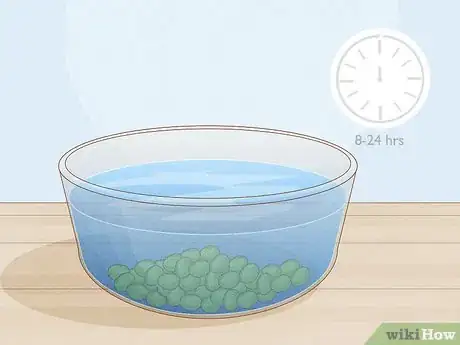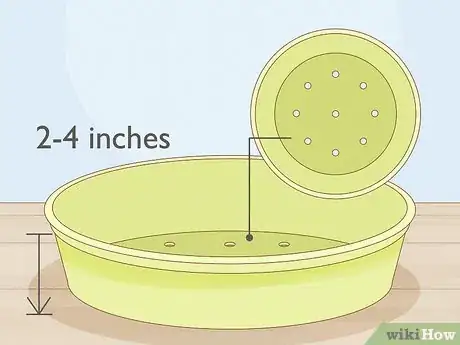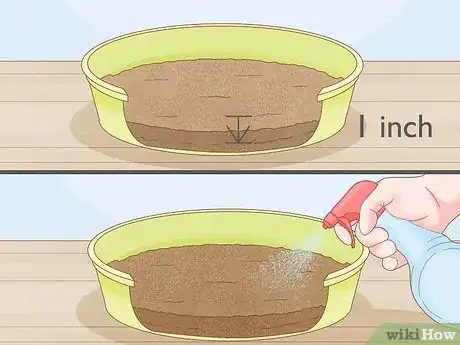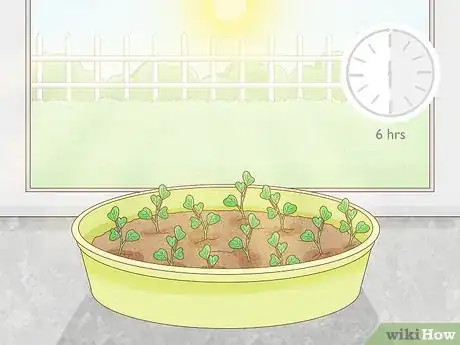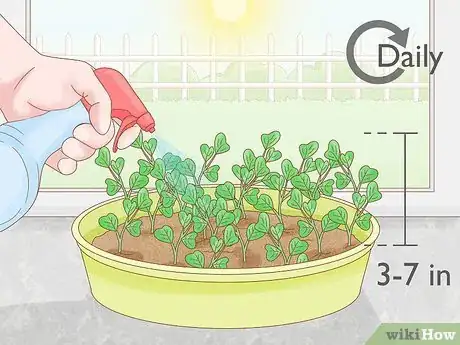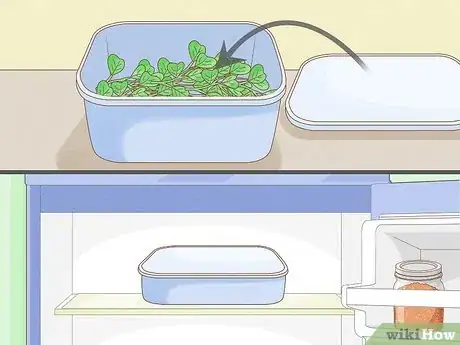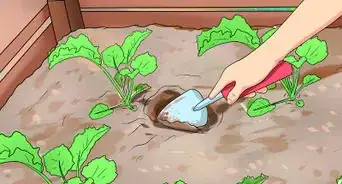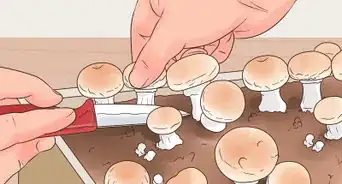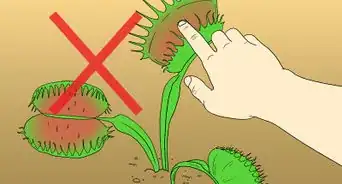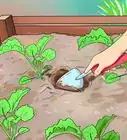This article was co-authored by wikiHow staff writer, Amber Crain. Amber Crain has been a member of wikiHow’s writing staff for the last six years. She graduated from the University of Houston where she majored in Classical Studies and minored in Painting. Before coming to wikiHow, she worked in a variety of industries including marketing, education, and music journalism. She's been a radio DJ for 10+ years and currently DJs a biweekly music program on the award-winning internet radio station DKFM. Her work at wikiHow supports her lifelong passion for learning and her belief that knowledge belongs to anyone who desires to seek it.
This article has been viewed 14,065 times.
Learn more...
Fresh pea sprouts are jam-packed with tons of healthy micronutrients and have a delicate, sweet flavor that's hard to resist. The sprouts are also super fast and easy to grow—once you plant the seeds, the first crop will be ready to harvest in about 3 weeks! Use your fresh, tender sprouts in green salads or blend them into your favorite smoothie recipes.
Steps
Seed Prep
-
1Soak pea seeds in tap or filtered water for 8-24 hours to soften them. Pour your seeds into a bowl and cover them with unchlorinated water. Leave the bowl where it won’t be disturbed for 8-24 hours so the seeds can soak. This softens the seed casings and speeds up the germination process.[1]
- Buy packets of English pea, snap pea, or snow pea seeds online or at your local nursery.
- If you're growing spouts outside and it’s still pretty chilly, it's fine to soak the seeds a little longer as long as you don't go over 72 hours.[2]
-
2Grab a shallow tray or container with plenty of drainage holes. Your planter or container only needs to be 2–4 in (5.1–10.2 cm) deep since sprouts won’t have time to develop extensive root systems. Any shallow container or wooden box will do the trick as long as it has plenty of holes in the bottom for the water to drain through.[3]
- Buy plastic planting trays from a gardening supply store, or improvise by using leftover blueberry or raspberry containers.[4]
- You can sow seeds directly in the ground, but it’s easier to control growing conditions in containers. The tiny sprouts are ready to harvest in 2-3 weeks.
- Seedlings grow close together in damp soil, so drainage is crucial to prevent mold and root rot.
Advertisement -
3Spread a 1 in (2.5 cm) layer of compost or soil in your planting tray. Commercial potting soil and organic compost both work great for sprouts. Pour a thin layer of soil or compost into the bottom of your tray and spread the surface out evenly.[5]
-
4Moisten the soil or compost generously with water. Fill a spray bottle with water and mist the top of the soil until it has the consistency of crumbly brownie mix. If you aren’t sure, just grab a handful of it and squeeze. If a few drops of water come out, the soil is ready. If a steady stream of water runs out, it’s too wet. Mix in a little soil to balance it out.[8]
- You don’t have to pre-moisten the soil, but it can speed up the germination process.
-
5Drain the seeds and place them on top of the soil 1⁄2 in (1.3 cm) apart. Dump the bowl of water and seeds into a fine-mesh strainer so the water passes through the bottom. Cover the surface of the soil with the seeds, taking care to put a little space between each seed.[9]
- Sprouts can grow close together, so don’t worry about being exact. Just try to avoid overlapping the seeds.[10]
- You don’t need to poke holes in the soil for the seeds. Put them right on top.
-
6Cover the seeds with 1 in (2.5 cm) of soil and mist the surface with water. Spread a thin layer of soil or compost over the seeds and use your hand to gently level the surface. Tamp the soil down lightly to get rid of any air pockets under the surface. Finish up by giving the surface a generous misting of water.[11]
Germination and Harvest
-
1Place the tray or container in a cool, shady area until the seeds sprout. Seeds germinate best when the soil temperature is 50–65 °F (10–18 °C) and the air temperature is 50–80 °F (10–27 °C). If you put the tray in direct sunlight, the soil might get a little too hot, so a cool, shady spot indoors or outdoors is ideal.[12]
- Early fall and early spring are the best times to grow pea sprouts outdoors on your porch or balcony. They can survive a light frost, so don't worry about that too much.
-
2Mist the soil every day to keep it evenly moist. Moisture and proper soil temperature are all pea seeds need to sprout! Moisten the soil once a day and you should see baby sprouts peeking up through the soil in about 3 days.[13]
- If you don’t see sprouts after 3 days, don’t worry! It can take up to 7 days.[14]
-
3Move the container or tray to a sunny location once the seeds sprout. After the seeds germinate, move them to a sunny area so your baby sprouts can grow and thrive. They need about 6 hours of sunlight a day. A sunny window or bright spot on your porch or balcony are great options. Seedlings prefer cool weather and are perfectly happy with temperatures as low as 40 °F (4 °C).[15]
- If full sun is too warm for them, they'll do fine in partial shade.
-
4Keep misting the sprouts daily until they’re 3–7 in (7.6–17.8 cm) tall. Keep the soil moist as your sprouts continue to grow. They're ready to harvest once they’re a few inches tall, which should only take about 2-3 weeks. The earlier you harvest the sprouts, the more tender and delicate their flavor will be.[16]
- Technically, you can harvest the tiny sprouts after the first true leaves appear, which happens within a matter of days rather than weeks. Once the sprouts grow more leaves and get a couple of inches tall, they become "pea shoots." People often say "pea sprouts" when they're actually referring to pea shoots. It's a bit confusing, but the only difference is the amount of growth!
-
5Snip the sprouts off at the base with scissors to harvest them. Use clean, sharp scissors to cut each shoot above the lowest node at the base of the stem. To get a second harvest, keep the tray in the same place and continue misting every day. In about 2 weeks, you should be able to harvest again![17]
- You can do this up to 3 times before the quality of the sprouts starts to go down.
-
6Store your harvested sprouts in the fridge for 2-3 days. Nestle the harvested sprouts in a covered container and store them in the fridge. When you’re ready to eat the sprouts, just rinse them off with cold water and use them to top salads or blend them into your favorite smoothie recipes.[18]
Warnings
- To prevent contamination, never grow your sprouts in fresh manure.[19]⧼thumbs_response⧽
Things You'll Need
- Shallow, flat containers with drainage holes
- Pea seeds
- Bowl
- Compost or potting soil
- Spray bottle
- Fine mesh strainer
- Scissors
References
- ↑ https://ucanr.edu/blogs/blogcore/postdetail.cfm?postnum=20295
- ↑ https://www.splendidtable.org/story/2015/04/24/growing-pea-shoots-step-by-step
- ↑ https://ucanr.edu/blogs/blogcore/postdetail.cfm?postnum=20295
- ↑ https://www.splendidtable.org/story/2015/04/24/growing-pea-shoots-step-by-step
- ↑ https://www.nparks.gov.sg/nparksbuzz/issue-04-vol-1-2010/gardening/pea-sprouts-easy-to-grow-and-tasty-too
- ↑ https://www.finegardening.com/article/grow-pea-shoots-for-spring-crunch
- ↑ http://pubs.cahnrs.wsu.edu/publications/wp-content/uploads/sites/2/publications/PNW567.pdf
- ↑ https://www.splendidtable.org/story/2015/04/24/growing-pea-shoots-step-by-step
- ↑ https://ucanr.edu/blogs/blogcore/postdetail.cfm?postnum=20295
- ↑ https://www.splendidtable.org/story/2015/04/24/growing-pea-shoots-step-by-step
- ↑ https://ucanr.edu/blogs/blogcore/postdetail.cfm?postnum=20295
- ↑ https://www.nparks.gov.sg/nparksbuzz/issue-04-vol-1-2010/gardening/pea-sprouts-easy-to-grow-and-tasty-too
- ↑ https://www.nparks.gov.sg/nparksbuzz/issue-04-vol-1-2010/gardening/pea-sprouts-easy-to-grow-and-tasty-too
- ↑ https://ucanr.edu/blogs/blogcore/postdetail.cfm?postnum=20295
- ↑ https://www.finegardening.com/article/grow-pea-shoots-for-spring-crunch
- ↑ https://www.nparks.gov.sg/nparksbuzz/issue-04-vol-1-2010/gardening/pea-sprouts-easy-to-grow-and-tasty-too
- ↑ https://www.nparks.gov.sg/nparksbuzz/issue-04-vol-1-2010/gardening/pea-sprouts-easy-to-grow-and-tasty-too
- ↑ https://www.finegardening.com/article/grow-pea-shoots-for-spring-crunch
- ↑ http://pubs.cahnrs.wsu.edu/publications/wp-content/uploads/sites/2/publications/PNW567.pdf
